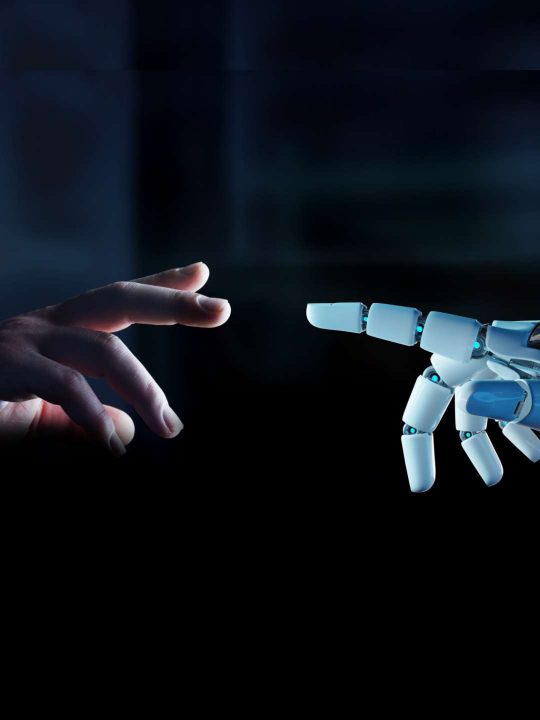Can technology really ever replace us?

“Minimizing human involvement in the customer experience is a dangerous game that short-sighted brands are playing. The winning formula lies within the seamless integration of human touchpoints with user-friendly technology”
“Robots are taking over!”, “We’re gonna be left jobless!” and “Automation is replacing humans” are the sort of comments we heard before coming to terms with AI and other such technology. We know that society is moving towards an increasingly automated work environment.
And according to the ONS, sales and customer services jobs are the ones at most risk. That’s good news… because whilst I remain skeptical about hopping on a pilotless aeroplane and even wearier of losing face-to-face interaction with my GP, I am prepared to accept that some aspects of customer service are better off automated.
I can think of many situations where I’d rather not have to deal with human contact… but, when it comes to customer experience, can technology really ever fully replace humans?
My initial response would be a resounding ‘no’. The facts clearly show that brands that have tested this have encountered issues. Take Sainsbury’s decision to revert cashier-free tills. Whilst the initiative intended to make the shopping experience quicker and easier, it led to chaos as some customers preferred alternative paying methods and ended up queuing for the helpdesk.
A CX conference I recently attended neatly summarised the relationship we should have with technology: “technology should be doing the heavy lifting that humans simply don’t have the bandwidth for”. The bots should be doing the straightforward tasks seamlessly and efficiently so that humans can be freed up to do the more complicated work, like the more involved customer requests. Yet they also claimed that “54.8% of [customer service related] travel conversations are highly suitable for bots” and evidence shows that CSAT, NPS and CES all improve when problems are solved quickly, whether it’s via a bot or a human.
These are conflicting insights, which is why we must be cautious with talking definites. Consumers say they would rather speak to a human until they have a positive experience with a bot. Behaviour changes attitudes. Which is why we must review how automating different aspects of CX affects the experience. What processes are more suited for automation and which ones would be better handled by a human?
I think the sweet spot lies in striving for experiences that seamlessly integrate with human interaction.
Which takes me back to the day I sold my old car on webuyanycar.com. I went onto their website to get a rough idea of how much I could flog it for… After inputting my details I immediately received a quote directing me to three local dealerships where I could trade in my car via an appointment available the following morning. The plan wasn’t to sell the car so soon, but the fact that I got a reasonable price and everything was arranged at such convenience made me bite the bullet.
The next day I completed the whole process of selling my second hand car so quickly (within 5 minutes) that I hadn’t even had time to reflect upon my decision. The digital experience was seamless, frictionless and easy, so much so that it was almost forgettable. What remains, however, is the emotional impact the manager had on my experience. As I was now carless, he kindly offered to give me a lift 2 miles away, even though he only had twenty minutes before his next appointment. It was the integration of both aspects that made the experience so rewarding.
A binary approach which promotes either technology or humans over each other is not a winning formula. You can’t have one without the other. We’ve seen this with Sainsbury’s and my car dealership. Technology is not exclusive to certain services or audiences. From our own research, we know that younger people, although happy to deal with day-to-day financial transactions digitally, still want a human touch when undergoing more complex transactions. Of course there are elements and processes that can be sped up (like finding my local dealerships and booking an appointment or rapidly buying last minute groceries with Apple Pay). But brands that go so far to the point where they minimise human involvement are short sighted.
It’s a little like ‘driverless cars’. The idea has been around for what seems like forever, and whereas I have no interest in befriending my taxi driver, some friendly banter does in fact improve my experience (and in turn day) to my otherwise conversation-less stressful commute in between meetings. It grounds me a little. Because in my opinion, to live in a society devoid of basic human interaction is to live in a less culturally rich and happy society.
So what can we take from this?
Essentially, that automation is a spectrum. The degree to which it is needed is subjective to service and audience. But ultimately, it aids in converting and retaining customers when it eases processes. It connects the dots between the end consumer and companies as they identify moments of demand upon which companies can act. In turn, humans within a company can spend more time doing what machines can’t, and technology can augment the customer journey by removing the unnecessary human interactions. A win-win if you hit your audiences’ and companies’ sweet spot.

 Back to articles
Back to articles

